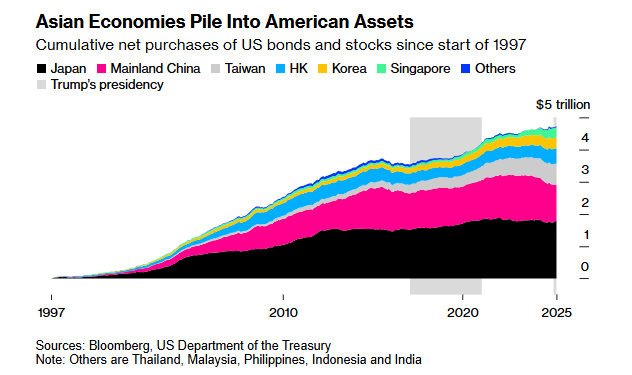1. Bullish Sentiment Nowhere Near Stretched

Bol
2. What Does Unwinding of Yen Carry Trade Mean?
Via Perplexity: The “unwinding of the yen carry trade” refers to the rapid reversal of a popular investment strategy where investors borrow Japanese yen at low interest rates to invest in higher-yielding assets or currencies elsewhere1236. Here’s how it works and what happens during an unwind:
How the Yen Carry Trade Works
Investors borrow yen at very low interest rates (thanks to Japan’s historically low monetary policy).
They convert those yen into another currency (like US dollars) and invest in assets that offer higher returns, such as US bonds or stocks.
The profit comes from the difference between the low yen borrowing cost and the higher yield on the foreign asset.
What “Unwinding” Means
Unwinding occurs when investors reverse these trades—often suddenly—because conditions have changed (e.g., rising interest rates in Japan, a strengthening yen, or falling returns abroad).
Investors sell their foreign assets, convert the proceeds back into yen, and repay their yen loans.
This process increases demand for yen, causing it to appreciate, and puts downward pressure on the prices of the assets being sold.
Why It Matters
The unwinding can trigger sharp moves in currency and global asset markets, sometimes leading to significant volatility or even market sell-offs.
As more investors unwind, the process can become self-reinforcing: a stronger yen makes existing trades less profitable, prompting even more unwinding.
Recent examples (such as in 2024) have shown that the unwinding of the yen carry trade can lead to large declines in stock and bond markets worldwide.
In summary:
The unwinding of the yen carry trade is when investors quickly exit positions funded by cheap yen borrowing, leading to a stronger yen and falling prices for riskier assets globally. This process can amplify market volatility and have broad ripple effects across financial markets.
3. Japanese Yen Chart…Right Now Yen Stopped Going Higher at Resistance Going Back to 2023

StockCharts
4. The Bank of Japan Owns 50% of the Japanese Government Bond Market

The Bank of Japan still owns a staggering 50 per cent-plus of the Japanese government bond market. But with deflation now in the rear view, the BoJ has started quantitative tightening — allowing its existing bond holdings to slowly hit the market. And as this one massive buyer has become a net seller, Japanese bond yields are normalising — aka rising.
FT Notes that Quasi-governmental entities like Japan Post, Norinchukin, and GPIF together own over a trillion dollars of foreign bonds. The government could urge them to support the Japanese bond market. But that would likely involve selling their foreign bond holdings — most likely Treasuries — to buy JGBs. “What Happens in Japan does not Stay in Japan.”

5. Japan’s 40-Year Bond Yield Hits Highest Level Ever

Barchart
6. Annual Flows from Asia into U.S. Assets Peaked in 2004
Via Bloomberg: The annual flows into the US peaked in 2004 at $354 billion as the ascendance of China, after joining the World Trade Organization, started to reshape trade and investments in the region. In the early 2000s, almost every dollar earned by the largest Asian exporters to America was reinvested back into its equity and bond markets given the high returns and growth seen in the world’s biggest economy.

The Global Financial Crisis of 2008 was a “major wake-up call,” exposing the fragility and risks in US markets, says David Gibson-Moore, president and chief executive officer of Gulf Analytica, a Dubai-based wealth advisory firm with Asian clients. Over the last decade, “sovereign wealth funds, family offices and institutional investors across Asia have gradually been rebalancing their portfolios to reduce overexposure to US assets.”
By 2024, Asia’s capital inflows into the country had dropped to $68 billion, making up just 11% of trade surpluses with the US that had continued to expand. Exports had ballooned in the past few years, aided by a strengthening dollar and a rebound in American consumption after Covid.
7. China Overall Global Exports Going Higher
“This [EU] episode also suggests the US is not trying to isolate China, as at one point seemed plausible … April data show that it is finding new customers. US exports are down badly, but total exports are at an all-time high.”

Blommberg
8. Over the Last 10 Years…300 American Colleges Closed

9. Countries with Most Child Marriages

Semafor
10. The Surprising Way to Tame Stress Fast
Via Consumer Reports: Learning to breathe deeply can foster relaxation. These breathing exercises can help you get started.
Life can sometimes be stressful. Health worries, financial concerns—even watching the news—can get you wound up.
And feeling tense isn’t just unpleasant, it’s also bad for your health. Chronic stress can contribute to or worsen sleep problems, headaches, gastrointestinal issues, high blood pressure, and depression and anxiety.
But there’s an easy, natural way to counteract stress: Take a deep breath.
Why Deep Breathing Is Calming
High-stress situations make you feel tense because they activate your sympathetic nervous system. This triggers the well-known fight-or-flight response, says Willie E. Lawrence Jr., MD, a preventive cardiologist and chief medical officer with the Cardiac and Vascular Interventional Group in Dallas. As a result, you breathe quickly and shallowly, your heart rate spikes, and your arteries narrow, which raises your
Breathing deeply counteracts this. It activates your diaphragm, a muscle at the bottom of your ribs, which stimulates the vagus nerve that runs from the brain to the abdomen. This activates your parasympathetic nervous system, lowers stress hormones, slows breathing, and brings your heart rate and blood pressure back to normal. The result: You start feeling calmer and more relaxed. Slowing your exhalations can enhance this, Lawrence says.
Of course, deep breathing won’t eliminate all of your tension. But studies have found plenty of positive effects. A 2023 meta-analysis published in Scientific Reports found that using various breathing techniques was linked to less overall stress and improved mental health. A 2019 review of three studies connected using your diaphragm muscle while breathing to a long-term reduction in stress levels and a short-term drop in blood pressure.
How to Get the Benefits
Most people breathe shallowly throughout their day. To learn how to breathe deeply, lie on your back, slowly inhale—letting your rib cage expand and your stomach rise—then exhale, letting them contract and fall. Over time, deep breathing more of the time may become natural for you.
Juanita Guerra, PhD, a clinical psychologist in New Rochelle, N.Y., and Lawrence also suggest doing exercises that slow your breathing, which can offer a reset when you’re under pressure. Try practicing one or more of the moves below once a day. (Start with three to five cycles at a time.)
- Box (or square) breathing: Inhale for four counts, hold your breath for four, exhale for four, and hold again for four.
- 4-7-8 breathing: Inhale through your nose for four counts, then hold your breath for seven. Then slowly exhale through your mouth for eight counts.
- Alternate nostril breathing: Close your right nostril with your thumb and inhale. Close your left nostril with your ring finger and release your thumb; exhale, and then inhale. Close your right nostril and exhale. Start again.
More Ways to Relax
Deep breathing may be even more effective at reducing stress when it’s done as part of another activity. That also helps you incorporate deep breathing more easily into your life, Lawrence says. Consider these options.
Yoga, Pilates, and tai chi: These exercises focus on controlling your breath while you’re moving your body.
Mindful meditation: Paying close attention to your breathing helps you focus on the present moment and not think about other things. It’s been found to reduce levels of stress hormones.
Spending time outdoors: Research has found that being in a natural setting like a park for just 20 minutes can lower stress hormone levels. If it’s difficult to get outside regularly, some evidence suggests that looking out a window or viewing natural scenes on a screen may help.
Editor’s Note: This article also appeared in the June 2025 issue of Consumer Reports On Health.